Cities4ZERO: Overcoming Carbon Lock-in in Municipalities through Smart Urban Transformation Processes
Abstract
1. Introduction
2. Materials and Methods
2.1. Smart Zero Carbon City: the Concept Underlying the Methodology
A Smart Zero Carbon City (SZCC) is a resource-efficient urban environment where carbon footprint is nearly eliminated; energy demand is kept to a minimum through the use of demand control technologies that save energy and promote raised awareness; energy supply is entirely renewable and clean; and resources are intelligently managed by aware and efficient citizens, as well as both public and private stakeholders [4].
2.2. Cities4ZERO Beta_0 Version: a Methodology from the Lab
2.3. Contrast of Cities4ZERO Beta_0.1 - From the Lab to the Urban Lab
2.4. Contrast of Cities4ZERO beta_0.2—From the urban lab to the real world
3. Results
3.1. A. Strategic Stage at City Level – CITY STRATEGY
Vitoria-Gasteiz 2030; a resilient, safe, healthy, metabolic efficient, circular and high-quality environmental municipality; a benchmark for distributed energy production from renewable sources, for an effective energy-retrofitting model of the built environment, for its determined commitment to the active mobility modes, complemented by a high-quality electrified public transport system. A municipality with institutions that exercise powerful leadership and act in an exemplary way together with a co-responsible citizenship with a high level of awareness, reinforced by a model of community cooperation capable of facing the challenges of the energy transition at the local level. All this within a prosperous, innovative, and competitive economic environment, which ensures a collaborative social model in which no one is left behind.
- a)
- City vision: carbon neutrality for 2030, based on green economic growth
- b)
- Strategic axis 1 (1 out of 3 axes): sustainable energy
- c)
- Strategic line 1.3 (out of 5 lines): positive energy districts
- d)
- Action 1.3.1 (out of 3 main actions): city diagnosis for vulnerable energy districts identification, promoting the “retrofitting pack” based on local businesses
- e)
- Key project from action 1.3.1: Integrated retrofitting of 350 dwellings in old town district, including connections to district heating network, powered by local renewable energy sources
Integrated energy planning (IEP) is an approach to find environmentally friendly, institutionally sound, socially acceptable, and cost-effective solutions of the best mix of energy supply and demand options for a defined area to support long-term regional sustainable development. It is a transparent and participatory planning process, an opportunity for planners to present complex, uncertain issues in structured, holistic, and transparent ways, for interested parties to review, understand and support the planning decisions. Furthermore, Integrated planning entails defining the goals and the problems to implement the appropriate solutions. [31]
3.2. Design Stage—DEVELOPMENT OF KEY PROJECTS
- Strategic, tactical: local partnership towards SZCC,
- Operational: technical committee (with main experts, including industry and academia),
- Collaborative: citizens committee, representing their interests and insights.
Intervention and Assessment Stage—IMPLEMENTATION OF KEY PROJECTS
- If the strategic plan and action plan are still considered valid after this process, and if an update is not yet necessary, the city can pick and develop new key projects coming back to Step 7 (7. PRIORITIZE), selected from the project list published in the action plan (Step 5).
- In case the strategic plan and/or action plan are considered as partially obsolete, where an update is appropriate for a better project focus, the city can come back to Step 4 (4. ENVISION) and update its strategic planning process for a reconsidered planning umbrella (strategic plan and action plan).
- If the strategic plan and action plan are still considered valid after this process, and if an update is not necessary, the city can pick and develop new key projects, coming back to Step 7 (7. PRIORITIZE), selected from the project list published in the action plan (Step 5).
- In case the strategic plan and/or action plan are considered to be partially obsolete, where an update is appropriate for a project’s improved focus, the city can come back to Step 4 (4. ENVISION) and update its strategic planning process for a reconsidered planning umbrella (strategic plan and action plan).
4. Discussion
4.1. Wider Support for Cities
The main value for Tartu in this process has been in creating a community of similarly motivated stakeholders. The process demands a lot of effort and communication and may prolong the planning process. But at the same time, it creates an emotionally and intellectually invested group of stakeholders. It will eventually give a planning document the stakeholder support it needs to succeed.
4.2. Towards Deeper Integration (Horizontal and Vertical)
- It allows cities to formulate cross-sectoral goals and to develop monitoring systems for cross-cutting policy fields, such as how to efficiently use natural resources, or reduce socio-economic disparities;
- It enables cities to develop strategies and projects that involve the knowledge and perspectives of different disciplines and actors from the civil and private sector;
- It helps cities with limited budgets and capacities to implement their goals more efficiently by joining capacities and funds, and by reducing trade-offs between sectors and neighbouring municipalities.
5. Conclusions
5.1. A Community of Practice with Shared Methodologies and Tools
smart city solutions are rarely a simple product or service. They often consist of complex urban interventions involving many different parties, each one with specific interests, agendas, and capacities. Everything must be there, at the right place, in the right moment: the technologies, the business models, the favourable legal context, the governance structure, social acceptance, user motivation, capacities and knowledge, budgets, aligned agendas, etc. [40]
5.2. The Way forward: Local Stakeholders Engagement and Digital Technologies for Improved Energy Planning
- We cannot invent our way towards a low carbon future without also engaging society—the sorts of changes that are required to urban infrastructure networks require not only new technologies, but also new forms of investment, new practices of energy use and new ways of working between the public and the private sector.
- Responding to these challenges requires not only capacity at the urban level and a proactive political climate, but also a willingness to create new forms of knowledge about cities and to operate beyond established practices and ways of doing things.
- Bringing transition to the city reminds us that what is at stake is not a simple choice between different paths to the future, but rather a complex and negotiated process—creating spaces in the city where diverse social interests can articulate and experiment with their visions for the future is a pressing policy challenge.
Supplementary Materials
Author Contributions
Funding
Acknowledgments
Conflicts of Interest
References
- Angel, S.; Parent, J.; Civco, D.; Blei, A.; Potere, D.T. A Planet of Cities: Urban Land Cover Estimates and Projections for All Countries, 2000–2050. In Lincoln Institute of Land Policy Working Paper; Lincoln Institute of Land Policy: Cambridge, MA, United States, 2010; pp. 1–103. [Google Scholar]
- World Health Organization. 9 out of 10 people worldwide breathe polluted air. 2018. Available online: https://www.who.int/news-room/detail/02-05-2018-9-out-of-10-people-worldwide-breathe-polluted-air-but-more-countries-are-taking-action (accessed on 9 March 2020).
- Lelieveld, J.; Klingmüller, K.; Pozzer, A.; Pöschl, U.; Fnais, M.; Daiber, A.; Münzel, T. Cardiovascular disease burden from ambient air pollution in Europe reassessed using novel hazard ratio functions. Eur. Heart J. 2019, 40, 1590–1596. [Google Scholar] [CrossRef] [PubMed]
- Urrutia, K.; Sorensen, S.; Molina, P.; Flores, I. Smart Zero Carbon City: Key Factors Towards Smart Urban Decarbonisation. DYNA 2019, 94, 676–683. [Google Scholar] [CrossRef]
- Altshuler, A. Costs of Sprawl. 3. Literature Review and Bibliography-Real Estate-Research Corporation. Am. Plan. Assoc 1977, 43, 207–209. [Google Scholar]
- Knowles, R. Energy and Form: An Ecological Approach to Urban Growth; The MIT Press: Cambridge, MA, USA, 1974. [Google Scholar]
- Owens, S. Energy, Planning and Urban Form; Applied En.: London, UK, 1986. [Google Scholar]
- Ratti, C.; Baker, N.; Steemers, K. Energy consumption and urban texture. Energy Build. 2005, 37, 762–776. [Google Scholar] [CrossRef]
- CONCERTO Premium. “Energy solutions for smart cities and communities. Lessons learnt from the 58 pilot cities of the CONCERTO initiative.” Steinbeis-Europa-Zentrum on behalf of the European Commission, DG Energy. Stuttgart 2014. Available online: https://op.europa.eu/es/publication-detail/-/publication/dbd458f6-6c1d-46ba-bb60-6921a07a8955/language-es (accessed on 27 February 2020).
- Giffinger, R.; Haindlmaier, G.; Hemis, H.; Kramar, H.; Strohmayer, F.; Weninger, K. Planning for Energy Efficient Cities. Methodol. Monit. 2014. Available online: https://publik.tuwien.ac.at/files/PubDat_240141.pdf (accessed on 28 April 2020).
- Consortium, I. In SMART Fact Sheet on CORDIS Website, 2014. Available online: https://cordis.europa.eu/project/id/314164 (accessed on 16 March 2020).
- Consortium, S.-U. Step-Up project website, 2014. Available online: https://www.stepup-project.eu/ (accessed on 16 March 2020).
- European Commission. Covenant of Mayors for Climate & Energy, 2020. Available online: https://www.covenantofmayors.eu/ (accessed on 19 March 2020).
- De Pascali, P.; Bagaini, A. “Energy Transition and Urban Planning for Local Development. A Critical Review of the Evolution of Integrated Spatial and Energy Planning”. Energies 2019, 12, 1–21. [Google Scholar]
- United Nations Framework Convention on Climate Change. COP21 Paris Agreement; 2015; pp. 1–16. Available online: https://unfccc.int/sites/default/files/english_paris_agreement.pdf (accessed on 15 January 2020).
- García, C. Integrated SmartEnCity Strategy _ V1; no. 691883; European Commission: Brussels, Belgium, 2018; pp. 1–100. [Google Scholar]
- Jimenez, C. City Needs and Baseline Definition Process and Methods; European Commission: Brussels, Belgium, 2016. [Google Scholar]
- Stendorf-Sørensen, S. Review of Regulatory Gaps and Recommendations to Facilitate City Transformation Processes; no. 691883; European Commission: Brussels, Belgium, 2017. [Google Scholar]
- Cepeda, M. New Business Models, Procurement Schemes and Financing Mechanisms for Smart City Projects; no. 691883; European Commission: Brussels, Belgium, 2016; Volume 2016, Available online: https://smartencity.eu/media/smartencity_d2.3_new_business_models_procurement_schemes_and_financing_mechanisms_for_smart_city_projects_v1.0_1.pdf (accessed on 28 April 2020).
- Rozanska, M. Recommendations for Updating Standards or Generating New Ones; no. 691883; European Commission: Brussels, Belgium, 2016; Volume 2016, p. 7. [Google Scholar]
- Cepeda, M. Integrated Management Models for Large Scale Smart City Transformation Projects; no. 691883; 2017; Volume 2017. [Google Scholar]
- Barrenetxea, E. Citizen Engagement Strategy and Deployment Plan; no. 691883; European Commission: Brussels, Belgium, 2016; pp. 1–130. [Google Scholar]
- SmartEnCity Consortium. Available online: http://smartencity.eu/ (accessed on 15 March 2020).
- EUROSTAT. “Statistics on European Cities. Population on 1 January, Total, 2014,” 2016. Available online: http://ec.europa.eu/eurostat/cache/RCI/#?vis=city.statistics&lang=en (accessed on 25 January 2017).
- SmartEnCity Consortium. “SmartEnCity Network.”. Available online: http://smartencity.eu/network/join-us/ (accessed on 5 March 2018).
- Urrutia, K.; Fontán, L.; Díez, F.J.; Rodíguez, F.; Vicente, J. Smart Zero Carbon City Readiness Level: Indicator System for City Diagnosis in the Basque Country moving towards Decarbonization. DYNA 2018, 94, 332–338. [Google Scholar]
- Alexander, E. Institutional Transformation and Planning: From Institutionalization Theory to Institutional Design. Plan. Theory 2005, 4, 209–223. [Google Scholar] [CrossRef]
- Aalborg University. Department Of Development And Planning, “EnergyPLAN. Advance Energy System Analysis Computer Model,” 2019. Available online: https://www.energyplan.eu/smartenergysystems/ (accessed on 20 April 2019).
- PlanEnergi, “Energy Balance Tool,” SmartEnCity Website, 2019. Available online: https://smartencity.eu/outcomes/tools/ (accessed on 20 April 2019).
- ProjectZero. Roadmap2025. 50 Steps Towards a Carbon Neutral Sonderborg; Bright Green Business ProjectZero: Sonderborg, Denmark, 2018; p. 64. [Google Scholar]
- Mirakyan, A.; De Guio, R. Integrated energy planning in cities and territories: A review of methods and tools. Renew. Sustain. Energy Rev. 2013, 22, 289–297. [Google Scholar] [CrossRef]
- European Commission, “Smart Cities Information System website,” 2020. Available online: https://smartcities-infosystem.eu/ (accessed on 9 March 2020).
- Gollner, C. Europe Towards Positive Energy Districts; JPI Urban Europe, 2020. Available online: https://jpi-urbaneurope.eu/app/uploads/2020/02/PED-Booklet-Update-Feb2020.pdf?utm_source=newsletter&utm_medium=email&utm_campaign=ue_nl_2020_02 (accessed on 1 March 2020).
- Group, C.C. “C40 Cities Website,” 2020. Available online: https://www.c40.org/ (accessed on 9 March 2020).
- United Nations, “Sustainable Development Goals Website,” 2020. Available online: https://sustainabledevelopment.un.org/ (accessed on 23 March 2020).
- Rivas, S.; Melica, G.; Kona, A.; Zancanella, P.; Serrenho, T.; Iancu, A.; Koffi, B.; Gabrielaitiene, I.; Janssesns-Mainhout, G.; Beroldi, P. The Covenant of Mayors: In-depth Analysis of Sustainable Energy Actions Plans; European Commission: Brussels, Belgium, 2015. [Google Scholar]
- Eisenbeiß, K. The SDGs Go Local! Why Cities Need to Engage in Integrated Urban Development; Urbanet, 2016. Available online: https://www.urbanet.info/sdgs-integrated-urban-development/ (accessed on 15 March 2020).
- Vandevyvere, H. Why May Replication (not) be Happening. Recommendations on EU R&I and Regulatory Policies; SCIS, European Commission: Brussels, Belgium, 2018. [Google Scholar]
- United Nations Environment Programme. District Energy in Cities: Unlocking the Potential of Energy Efficiency and Renewable Energy; 2015. Available online: https://wedocs.unep.org/handle/20.500.11822/9317 (accessed on 10 January 2020).
- Gabrielaitiene, I.; Melica, G.; Abulashvili, G.; Bertoldi, P. The Covenant of Mayors: Evaluation of Sustainable Energy Action Plans from Eastern Partnership and Central Asian Countries; European Commission: Brussels, Belgium, 2017. [Google Scholar]
- Bulkeley, H.; Castan Broto, V.; Hodson, M.; Marvin, S. Cities and the Low Carbon Transition. Eur. Financ. Rev. 2011. Available online: https://www.europeanfinancialreview.com/cities-and-the-low-carbon-transition/ (accessed on 18 December 2019).
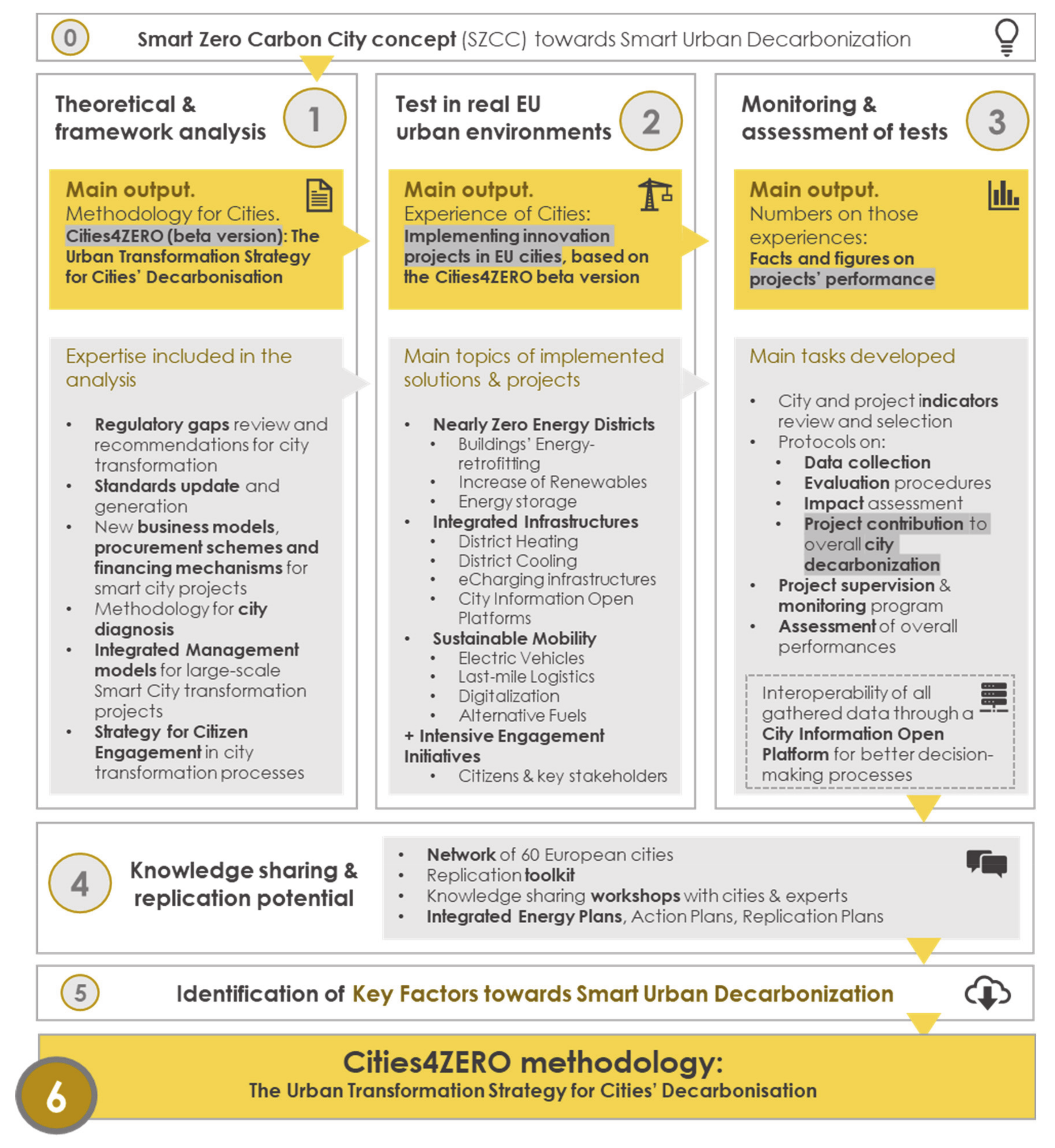

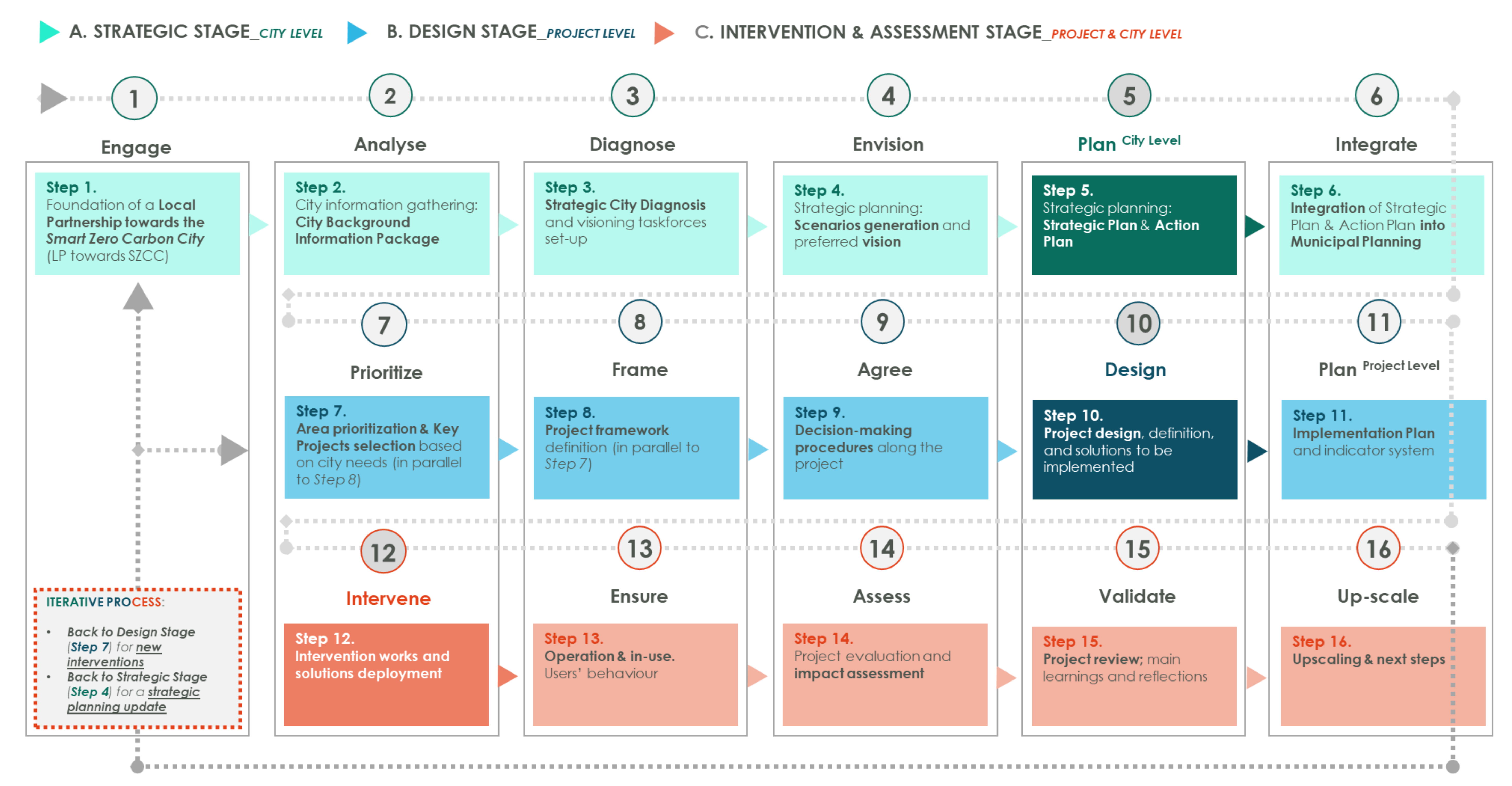
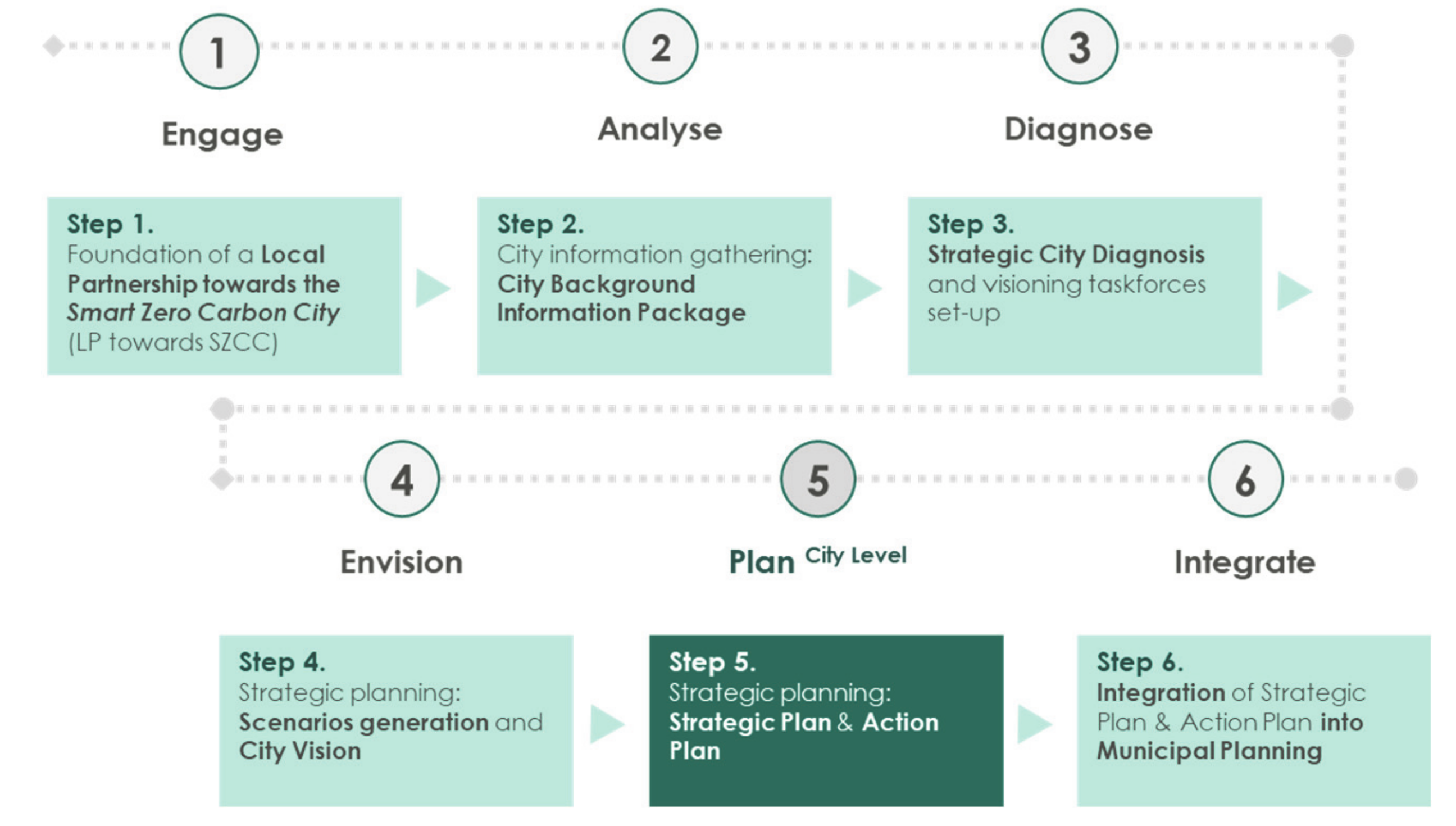
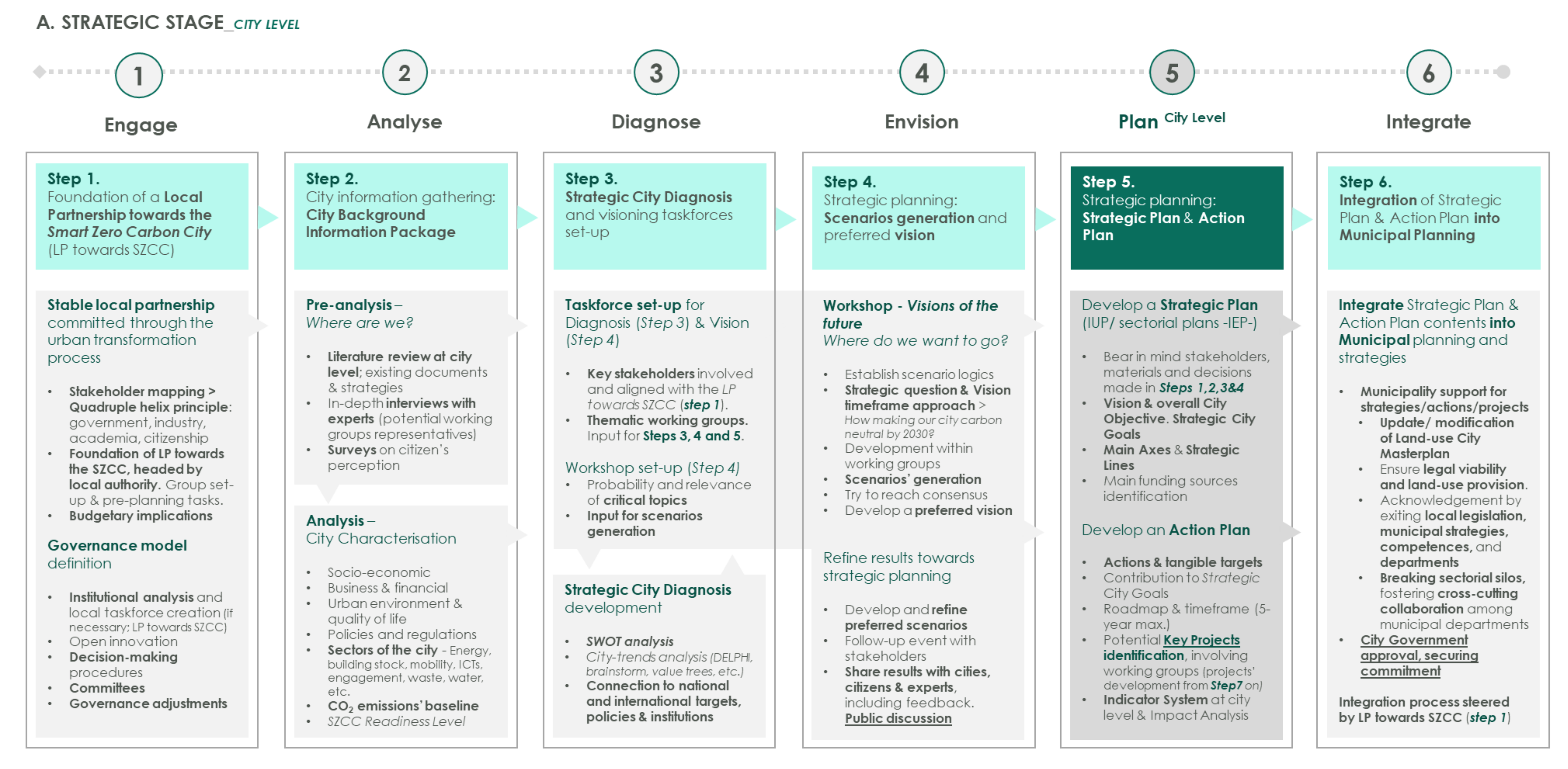

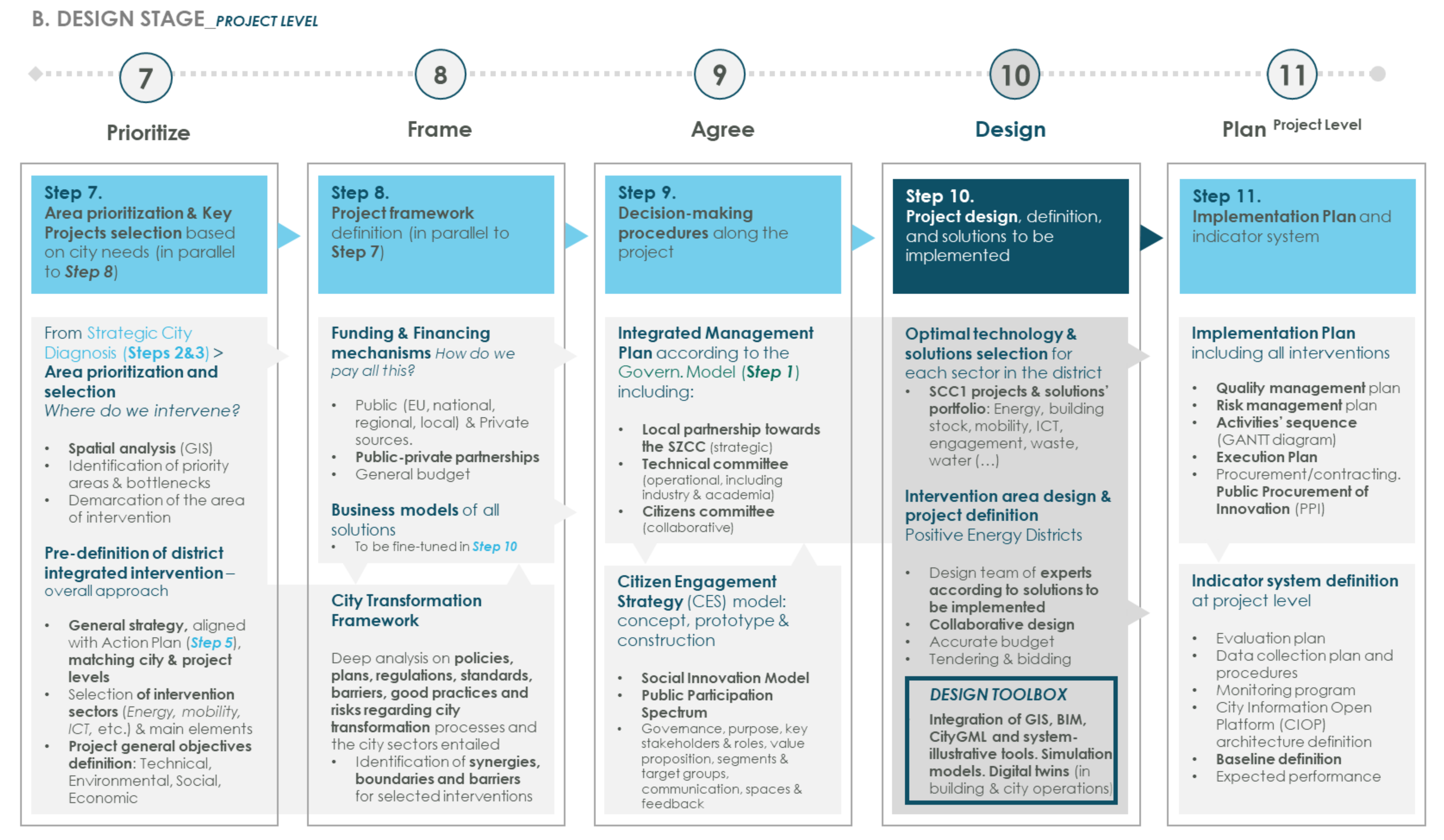

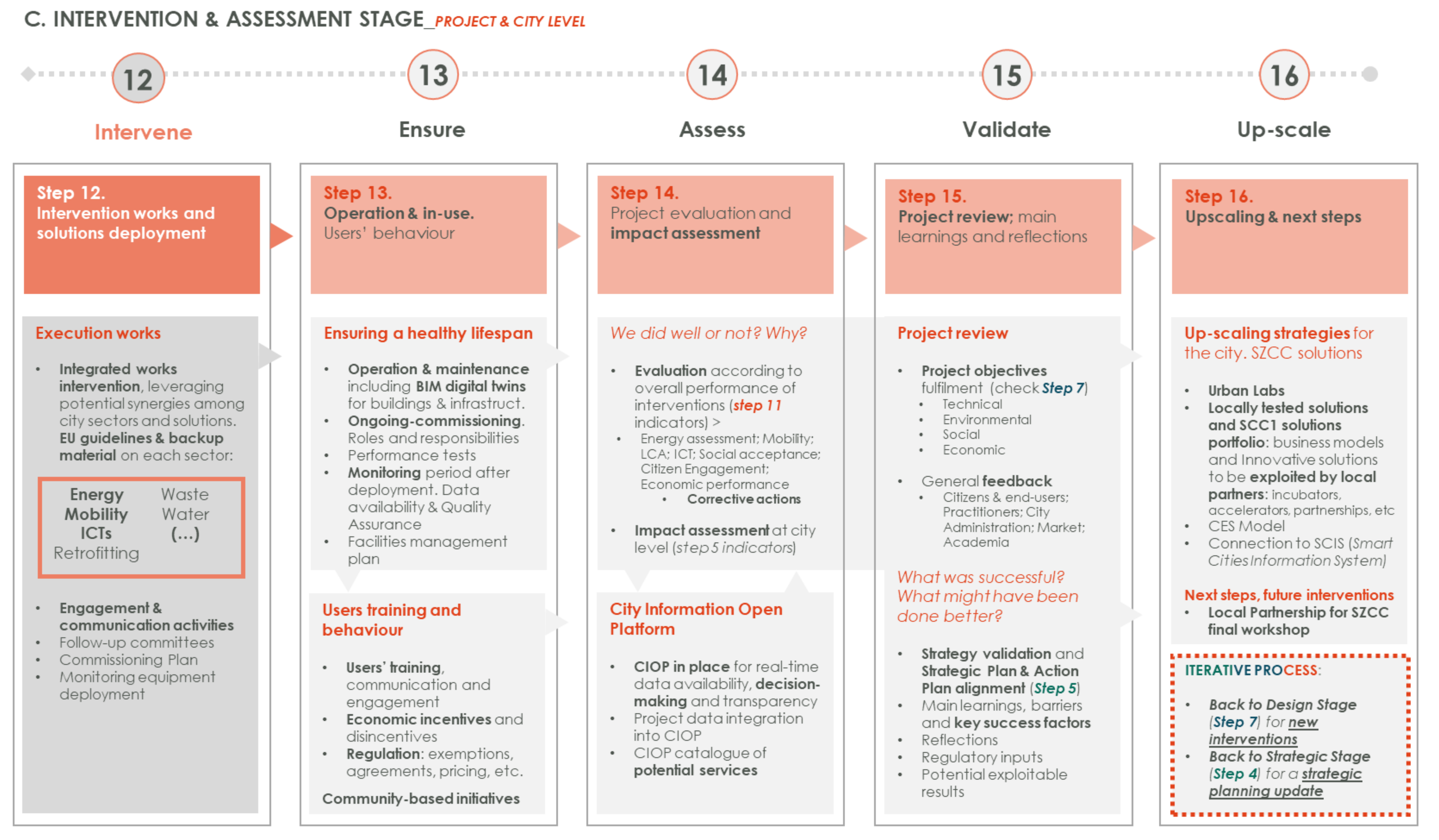
| Vitoria-Gasteiz | This administrative capital of the Basque Country, in northern Spain, has a population of 240,000 inhabitants, with an extension of 276.81km2. A compact, moderately dense city, Vitoria-Gasteiz has an extensive background in the planning and implementation of environmental policies, being awarded the European Green Capital appointment in 2012. A flat and walkable city surrounded by a "green belt", and often regarded as a model in sustainable mobility planning, Vitoria-Gasteiz is committed to becoming a carbon-neutral city by 2050. |
| Tartu | Tartu is the second-largest city in Estonia, with a population of 100,000 inhabitants and a total area of 38.86km2. The home of several knowledge-intensive organizations (University of Tartu, Estonian University of Life Sciences), it is better known for its extensive implementation of Smart technologies in the Urban Environment. Tartu implemented public Wi-Fi areas throughout the city and was the first city in the world to enable a mobile-payment system for street parking in 2000. Paperless government was implemented in 2003, e-elections in 2005 and 2011 (EU Parliament), and fully electric taxi service and charging grid were implemented in 2012. |
| Sonderborg | Sixteenth largest municipality in Denmark, with approximately 77,000 inhabitants, included in the Southern Denmark region. The municipality holds an extensive agriculture sector, some of Denmark’s largest industrial companies (i.e., Danfoss), and some of the most beautiful natural resorts of the country, with a cost of approximately 200km (offshore wind potential) and vast forests (local biomass potential). The city of Sonderborg has been working with the “ProjectZero” roadmap since 2007, aiming to become carbon neutral by 2029; one of the worldwide pioneer cities in this regard. |
| Energy Savings (kWh/Year) | CO2 Emission Reduction (Tn/Year) | |||||
|---|---|---|---|---|---|---|
| DISTRICT INTERVENTIONS | Building Retrofitting |
| 6,099,700 | 2149 | VITORIA-GASTEIZ | |
| Integrated Infrastructures |
| |||||
| Sustainable Mobility |
| |||||
| ICTs |
| |||||
| CITY STRATEGY |
| Baseline 2006: 841,068 CO2 tn/yr 2020: 624,728 CO2 tn/yr Next target by 2030 (-40%): 504,640 CO2 tn/yr | ||||
| DISTRICT INTERVENTIONS | Building Retrofitting |
| 16,080,829 | 12,244 | TARTU | |
| Integrated Infrastructures |
| |||||
| Sustainable Mobility |
| |||||
| ICTs |
| |||||
| CITY STRATEGY |
| Baseline 2010: 540,794 CO2 tn/yr 2020: 432,635 CO2 tn/yr Next target by 2030 (-40%): 324,477 tn/yr | ||||
| DISTRICT INTERVENTIONS | Building Retrofitting |
| 16,080,829 | 12,244 | SONDERBORG | |
| Integrated Infrastructures |
| |||||
| Sustainable Mobility |
| |||||
| ICTs |
| |||||
| CITY STRATEGY |
| Baseline 2007: 701,044 CO2 tn/yr 2018: 432,336 CO2 tn/yr Next target by 2025 (-75%): 175,261 tn/yr | ||||
| A. Strategic Stage City Level | CITY STRATEGY |
STEPS 1–6. They provide a strategic planning framework which enables the city administration to perform an effective transition towards the Smart Zero Carbon City (SZCC), including:
| |
| B. Design Stage Project Level | DEVELOPMENT AND IMPLEMENTATION OF KEY PROJECTS |
STEPS 7–11. They guide municipalities through the development of key projects identified in Stage A, according to the strategic plans of the city, paving the way for tangible interventions towards the SZCC, including:
| |
| C. Intervention and Assessment Stage Project and City Level | |
STEPS 12–16. They structure the implementation and assessment of key projects identified in Stage A and designed in Stage B, finally transforming the urban environment; including:
|
| A. Energy | |
|---|---|
| Energy efficiency in buildings |
| Energy system integration |
| B. Mobility and transport | |
| |
| C. ICTs | |
|
| INTEGRATION THROUGH LOCAL STAKEHOLDERS’ ENGAGEMENT |
|---|
| STEP 1. Governance model definition and local taskforce foundation (institutional analysis) |
| STEPS 3–5. Shared vision and strategic planning among key local stakeholders |
| STEP 9. Decision-making procedures and agreements along each project (local community) |
| STEPS 12–13. Engagement activities during implementation and end-users’ training |
| STEP 16. Shared reflection for next steps and future decarbonization interventions |
| HORIZONTAL INTEGRATION AMONG CITY SYSTEMS AND WITHIN CITY PLANNING STRUCTURES |
| STEP 1. Foundation of a local task force, stable in time engaging diverse expertise |
| STEPS 2–3. Shared sectorial analysis and diagnosis from an integrated perspective |
| STEPS 4–5. Strategic planning, integrating all sectorial perspectives from vision to action plan |
| STEP 6. Integration of action plan outcomes into city planning procedures (integration booklet) |
| STEPS 7–11. Design stage is conceived as an integrated process where all city systems and stakeholders converge once the project and the area of intervention are selected: general strategy (7), financing and overall framework (8), design and solutions (9) and implementation plan (10) |
| STEPS 12–14. Interventions are planned and executed, considering potential synergies and barriers among sectorial projects (12); commissioning, and assessing the project as one package. |
| STEPS 15–16. The integration becomes multi-scale, when project validation means a partial city strategy validation (15), and successful interventions can be applied transversally in the city, stimulating even different sectors of the city (16) |
| VERTICAL INTEGRATION AMONG PUBLIC AUTHORITIES FROM OTHER GOVERNMENT SCALES (REGIONAL, NATIONAL, EU) |
| STEP 1. Governance model definition, including multi-level governance mechanisms |
| STEPS 2–3. Analysis of regional, national and European strategies, including the external global city trends that may affect the city in the coming years as part of the diagnosis |
| STEP 4. Involve regional agencies’ stakeholders in the visioning task |
| STEP 5. Local planning considering regional, national and EU initiatives, looking for synergies that potentially enable a more straightforward implementation of the actions identified |
| STEP 6. Municipal integration involving regional agencies when urban competences require this |
| STEPS 7–12. Project collaboration of regional agencies when urban competences require this |
| STEPS 15–16. Involvement of regional agencies in the upscaling task. Coordination with national and European best-practices repositories, facilitating the exchange of knowledge among cities. This contrast will enrich the iterative city strategic planning process |
© 2020 by the authors. Licensee MDPI, Basel, Switzerland. This article is an open access article distributed under the terms and conditions of the Creative Commons Attribution (CC BY) license (http://creativecommons.org/licenses/by/4.0/).
Share and Cite
Urrutia-Azcona, K.; Tatar, M.; Molina-Costa, P.; Flores-Abascal, I. Cities4ZERO: Overcoming Carbon Lock-in in Municipalities through Smart Urban Transformation Processes. Sustainability 2020, 12, 3590. https://doi.org/10.3390/su12093590
Urrutia-Azcona K, Tatar M, Molina-Costa P, Flores-Abascal I. Cities4ZERO: Overcoming Carbon Lock-in in Municipalities through Smart Urban Transformation Processes. Sustainability. 2020; 12(9):3590. https://doi.org/10.3390/su12093590
Chicago/Turabian StyleUrrutia-Azcona, Koldo, Merit Tatar, Patricia Molina-Costa, and Iván Flores-Abascal. 2020. "Cities4ZERO: Overcoming Carbon Lock-in in Municipalities through Smart Urban Transformation Processes" Sustainability 12, no. 9: 3590. https://doi.org/10.3390/su12093590
APA StyleUrrutia-Azcona, K., Tatar, M., Molina-Costa, P., & Flores-Abascal, I. (2020). Cities4ZERO: Overcoming Carbon Lock-in in Municipalities through Smart Urban Transformation Processes. Sustainability, 12(9), 3590. https://doi.org/10.3390/su12093590





